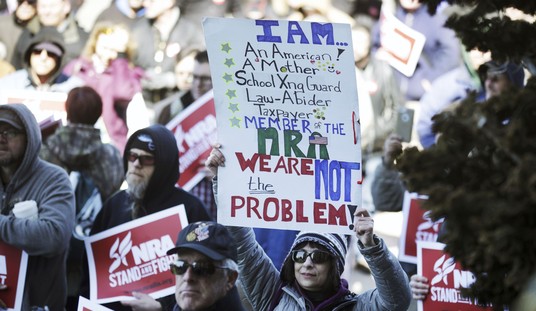As is usually the case in situations like these, we're learning more about the multiple warning signs exhibited by the deranged individual who opened fire in Lakewood Church in Houston, Texas on Sunday, including repeated arrests and a history of mental illness going back years. But the attacker's ex-mother-in-law claims that the real problem is the right to keep and bear arms, as well as a lack of a "red flag" law in the Lone Star State.
Authorities have already said that Genesse Moreno had a documented history of mental illness, including an emergency detention order eight years ago, but there is no indication that family members tried to have her involuntarily committed at any point since, even though her then-husband alleged just three years ago that he was subject to physical attacks by his wife.
KPRC 2′s Bryce Newberry dug deep into documents, including divorce records that reveal details on what police called a “documented mental history” and a possible connection to the megachurch.
Records said in 2021, her ex-husband told a judge that Moreno would “physically attack” him and “on multiple occasions, chased (him) out of the house with knives.”
The custody battle for their child, who was injured in Sunday’s shooting at Lakewood Church, started in Harris County, records show, but ended in Montgomery County. While the child’s father was granted custody in Harris County, a new trial in Montgomery County as part of a venue transfer had the opposite outcome, records show.
During the Montgomery County case, more records revealed the child’s paternal grandmother asked a judge to appoint her as temporary conservator, claiming Moreno had schizophrenia and didn’t always take her prescribed medication.
If that was the case, then why didn't the grandmother try to have Moreno committed to a mental hospital for treatment, rather than asking to serve as a conservator? As the Texas Bar Association explains on its website, there are important differences between the two.
There is a difference between guardianship andinvoluntary commitment. As explained above,involuntary commitment is the use of legal means to commit a person to a mental hospital or psychiatricward against their will or over their protests. Guardianship is the use of legal means to grant another person or entity full or limited authority over an incapacitated person (ward) to promote and protect the well-being of the ward. In guardianships, the guardian is NOT allowed to commit the ward to a mental hospital, insane asylum or psychiatric ward. In guardianships, the guardian’s role is to step into the shoes of the ward because they are incapacitated and unable to perform the functions necessary to manage themselves or their estate. Involuntary commitments are used only to assist the mentally ill with getting necessary medical treatment for their mental illness. The persony ou are trying to help may not be incapacitated; they simply need medical attention to help them with their problem.
Sounds to me like a commitment would have been the more appropriate step, given the accusations of violent behavior by Moreno and her unwillingness or inability to take her prescribed medication. But Moreno's ex-mother-in-law is now placing the blame for the attack on government agencies in the Lone Star State, the Second Amendment, and the absence of a "red flag" law.
Carranza said Moreno had a history of mental illness and her family had raised red flags for years.
"She had a particular kind of schizophrenia that caused her to become violent," she said. "She threatened her husband, my own son, and we still couldn't get intervention."
Carranza said she's frustrated with the system that she believes failed their family.
"We asked for help from CPS. ... We asked for help from police and received it many times but she was still allowed to own guns," Carranza said.
In a post on Facebook, Willi Carranza went even further, declaring, "the fault lies in a child protective services of Montgomery County and Harris County that refused to remove custody from a woman with known mental illness that was not being treated and with the state of Texas for not having strong red flag laws that would have prevented her from owning or possessing a gun. Let it be clear that the second amendment stops where the first amendment right to life begins and it's time to remove from the US Constitution any protection for gun ownership."
Nonsense. First of all, a "red flag" law wouldn't have prevented Moreno from illegally obtaining a gun, or using other weapons like, say, the knives she allegedly used to threaten her ex-husband. It certainly wouldn't have done anything to force her to receive treatment for her schizophrenia, because "red flag" laws typically have no mental health component to them whatsoever. Extreme Risk Protection Orders take away any lawfully owned firearms, while leaving the supposedly dangerous person to their own devices.
Based on what we know now, the time to remove Moreno from the general public and confine her to a mental institution for treatment was years ago. The question is why that step was apparently never taken, outside of the emergency detention order in 2016. If there were documented incidents of violence against others, along with a lack of self-care, then the requirements for an involuntary commitment should have been met.
(1) a statement that the guardian [or applicant] has reason to believe and does believe that the ward evidences mental illness;(
2) a statement that the guardian [or applicant] has reason to believe and does believe that the ward evidences a substantial risk of serious harm to the ward or others;
(3) a specific description of the risk of harm;
(4) a statement that the guardian [or applicant] has reason to believe and does believe that the risk of harm is imminent unless the ward is immediately restrained;
(5) a statement that the guardian’s [or applicant’s]beliefs are derived from specific recent behavior, overt acts, attempts, or threats that were observed by the guardian [or applicant]; and(6) a detailed description of the specific behavior,acts, attempts, or threats.
Based on Carranza's own comments and court records there were plenty of people who could have attested to Moreno's risk of serious harm to others, including overt acts of violence and threats observed (and directed to) family members.
Now, it's possible that as we learn more about Moreno's history we'll discover that there were multiple attempts to commit her to a mental institution, but so far it sounds like the only time that was tried was nearly a decade ago, and in the ensuing years her mental illness and threats of violence became even more overt since then.
It's also possible that there is fault to be found in the government agencies that Carranza claims routinely turned a blind eye to Moreno's increasingly erratic and threatening behavior, but to blame the Second Amendment for Moreno's violence on Sunday is an act of delusion all its own.









Join the conversation as a VIP Member